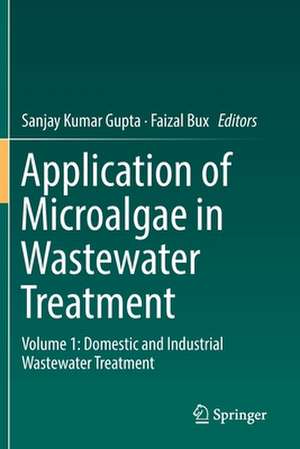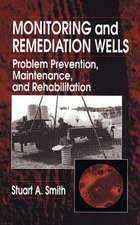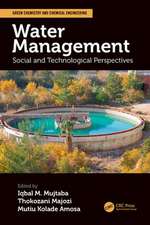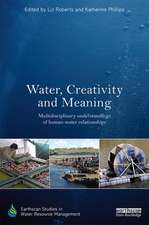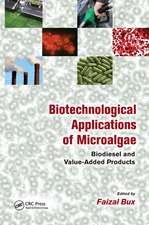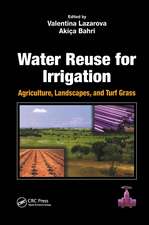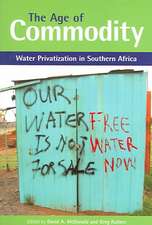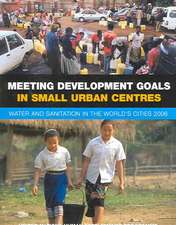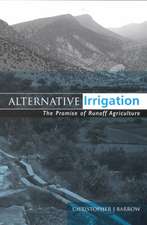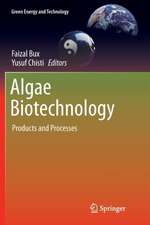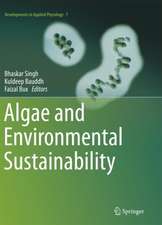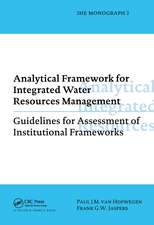Application of Microalgae in Wastewater Treatment: Volume 1: Domestic and Industrial Wastewater Treatment
Editat de Sanjay Kumar Gupta, Faizal Buxen Limba Engleză Paperback – 28 oct 2020
Volume 1 focuses on the different aspects of domestic and industrial wastewater treatment by microalgae. The case studies include examples such as genetic technologies as well as the development and efficient use of designer consortia for enhanced utilization of microalgae. This volume provides thorough and comprehensive information on removal of persistent and highly toxic contaminants such as heavy metals, organic pesticides, polyaromatic hydrocarbons, endocrine disruptors, pharmaceutical compounds, and dyes from wastewater by microalgae, diatoms, and blue-green algae. Design considerations for algal ponds and efficient use of photobioreactors and HRAPs for wastewater treatment are some other highlights. This volume addresses the applications, potentials, and future opportunities for these various considerations in water pollution mitigation using algal technologies.
| Toate formatele și edițiile | Preț | Express |
|---|---|---|
| Paperback (2) | 583.50 lei 38-44 zile | |
| Springer International Publishing – 15 aug 2020 | 583.50 lei 38-44 zile | |
| Springer International Publishing – 28 oct 2020 | 591.47 lei 6-8 săpt. | |
| Hardback (2) | 602.24 lei 38-44 zile | |
| Springer International Publishing – 3 iun 2019 | 602.24 lei 38-44 zile | |
| Springer International Publishing – 3 iun 2019 | 659.56 lei 38-44 zile |
Preț: 591.47 lei
Preț vechi: 695.84 lei
-15% Nou
Puncte Express: 887
Preț estimativ în valută:
113.19€ • 122.91$ • 95.08£
113.19€ • 122.91$ • 95.08£
Carte tipărită la comandă
Livrare economică 23 aprilie-07 mai
Preluare comenzi: 021 569.72.76
Specificații
ISBN-13: 9783030139155
ISBN-10: 3030139158
Pagini: 437
Ilustrații: XIV, 437 p. 72 illus., 52 illus. in color.
Dimensiuni: 155 x 235 mm
Greutate: 0.63 kg
Ediția:1st ed. 2019
Editura: Springer International Publishing
Colecția Springer
Locul publicării:Cham, Switzerland
ISBN-10: 3030139158
Pagini: 437
Ilustrații: XIV, 437 p. 72 illus., 52 illus. in color.
Dimensiuni: 155 x 235 mm
Greutate: 0.63 kg
Ediția:1st ed. 2019
Editura: Springer International Publishing
Colecția Springer
Locul publicării:Cham, Switzerland
Cuprins
Chapter1: Phycoremediation Technology: A Global prospective.- Chapter2: The diatoms: from eutrophic indicators to mitigators.- Chapter3: A review on micropollutants removal by microalgae.- Chapter4: Developing designer microalgae consortia: A suitable approach to sustainable wastewater treatment.- Chapter5: Outdoor Microalgae Cultivation for Wastewater Treatment.- Chapter6: Current state of knowledge on algae mediated remediation of Endocrine Disrupting Chemicals (EDCs) from wastewater.- Chapter7: Bioremediation of municipal sewage using potential microalgae.- Chapter8: Phycoremediation of Petroleum Hydrocarbons Polluted Sites: Application, Challenges and Future Prospects.- Chapter9: Genetic Technologies and Enhancement of Algal Utilization in Wastewater Treatment and Bioremediation.- Chapter10: Potential and Feasibility of the Microalgal system in removal of pharmaceutical compounds from wastewater.- Chapter11: Phycoremediation of persistent organic pollutants from wastewater: Retrospect and prospects.- Chapter12: Feasibility of microalgal technologies in pathogens removal from wastewater.- Chapter13: Remediation of domestic wastewater using algal-bacterial biotechnology.- Chapter14: Phycoremediation of textile waste water: Possibilities and Constraints.- chapter15: Potential and application of Diatoms for industry-specific wastewater treatment.- Chapter16: Feasibility of using bacterial-microalgal consortium for the bioremediation of organic pesticides: Application constraints and future prospects.- Chapter17: Potential of blue-green algae in wastewater treatment.- Chapter18: Photobioreactors for Wastewater Treatment.- Chapter19: Design considerations of algal systems for wastewater treatment.- Chapter20: Phycoremediation of heavy metals from water and wastewater.
Notă biografică
Dr. Sanjay Kumar Gupta is Technical Superintendent of Environmental Engineering in the Department of Civil Engineering at the Indian Institute of Technology, Delhi. Dr. Gupta started his research carrier in 1999 at CSIR-Indian Institute of Toxicology Research, Lucknow India. His doctoral research was awarded in 2010 from Dr. Ram Manohar Lohia Avadh University, Faizabad. Later, he did his post-doctoral research from Durban University, South Africa. He had been recognized twice as “One of the Top Publisher Post-Doc Fellow” in 2014 and 2016 for his active research contribution for his post-doctoral research. Dr. Gupta has authored 61 articles in peer-reviewed journals and books, have presented 17 papers in national and international conference. One of his book “Algal Biofuels” published from Springer International, Switzerland was one of the most downloaded book in 2017. He was an Editor for Journal of Ecophysiology and Occupational Health, and is a life member of many professionalsocieties including the International Society of Environmental Botanists, Society of Toxicology, Academy of Environmental Biology, and the Indian Network for Soil Contamination Research. His research interests include ecotoxicological risk assessment, bioremediation of wastewater and industrial effluents, algal biotechnology.
Dr. Faizal Bux is Director of the Institute for Water and Wastewater Technology at Durban University of Technology in South Africa. He received his B.Sc. from University of Durban-Westville in 1986, his M.Tech. in Biotechnology from Technikon Natal in 1997, and his Ph.D. in Biotechnology from Durban institute of Technology in 2003. He has edited 5 books, written 121 articles in peer-reviewed journals, authored 17 book chapters, and is an Editor for the journals Environmental Science and Health, Biofuels Research Journal, and Water Science and Technology. His research interests include biological nutrient removal in wastewater treatment, algal biotechnology, and bioremediation of industrial effluents.
Textul de pe ultima copertă
This two-volume work presents comprehensive, accurate information on the present status and contemporary development in phycoremediation of various types of domestic and industrial wastewaters. The volume covers a mechanistic understanding of microalgae based treatment of wastewaters, including current challenges in the treatment of various organic and inorganic pollutants, and future opportunities of bioremediation of wastewater and industrial effluents on an algal platform. The editors compile the work of authors from around the globe, providing insight on key issues and state-of-the-art developments in algal bioremediation that is missing from the currently available body of literature. The volume hopes to serve as a much needed resource for professors, researchers and scientists interested in microalgae applications for wastewater treatment.
Volume 1 focuses on the different aspects of domestic and industrial wastewater treatment by microalgae. The case studies include examples such as genetic technologies as well as the development and efficient use of designer consortia for enhanced utilization of microalgae. This volume provides thorough and comprehensive information on removal of persistent and highly toxic contaminants such as heavy metals, organic pesticides, polyaromatic hydrocarbons, endocrine disruptors, pharmaceutical compounds, and dyes from wastewater by microalgae, diatoms, and blue-green algae. Design considerations for algal ponds and efficient use of photobioreactors and HRAPs for wastewater treatment are some other highlights. This volume addresses the applications, potentials, and future opportunities for these various considerations in water pollution mitigation using algal technologies.
Caracteristici
Presents key issues and opportunities in domestic and industrial wastewater treatment on a microalgae platform Uniquely compiles the phycoremediation potential of various algal species for applications in domestic and industrial wastewater treatment Evaluates the economic potential of pilot scale phytoremediation projects
